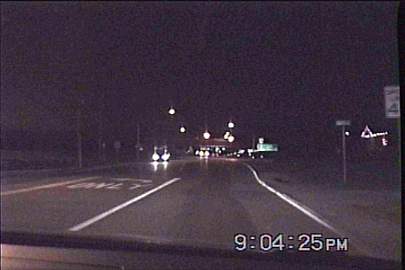
It's Happening Again!
The Pine Bush Phenomenon has struck again!!!
by Bruce Cornet, Ph.D.
Table of Contents
On 18 December 1999 Bruce Cornet took Herm Fischer, a colleague from California, on a tour of the Wallkill River Valley, where he had conducted seven years of research on the Pine Bush Phenomenon. Because the area had not experienced much AOP activity during the past two years (based on rare sightings), he had hopes but no emotionally - bound expectations that they would be lucky enough to see an AOP, let alone be treated to a mind-bending performance. After touring the valley, taking many pictures, and talking to residents, Cornet and Fischer settled down for several hours of night watching from the edge of a farm field near the old Jewish Cemetery on Rte 52. All they saw were conventional aircraft. At about 8:40 disappointed they began their trip back home. They drove to the town of Walden on Rte. 52, and then took Rte 208 south to I-84, which crosses New York State from west to east.
As they approached a traffic light just before the highway interchange Cornet spotted a bright light off in the distance which seemed to be pacing their car. Fischer was driving. Cornet had his camcorder ready, because on several occasions in the past AOP had suddenly shown up either just before or just after he got on the highway.
On one occasion back on 10 June of 1995 Cornet and his wife had given a tour to their friend Sharon Cunningham, who came up from Maryland for a visit. They had seen nothing that evening (similar to this evening), and were all disappointed. As Cornet drove onto the entrance ramp to I-84 at the same interchange they joked about seeing an AOP as they were leaving. But no sooner had they gotten on the highway traveling east when Cornet spotted a bright set of headlights in his rear view mirror. The headlights caught his attention because they were coming up fast - much too fast for a vehicle and certainly much faster than the speed limit of 65 mph. The lights were catching up to their van at the speed of an aircraft (at possibly more than 200 mph)! Cornet yelled to his two passengers to look behind them. They both screamed as the headlights seemed to be on a collision course with the van and certain disaster. But about 500 feet behind them the lights lifted up off the highway and flew over the trees along side the highway, slowing rapidly to the speed of their van. There were several additional lights behind the two headlights, but no one in the van was composed enough to count them. Cunningham yelled out in anger at what she thought was cruel alien humor. Cornet instructed his wife to get his camcorder, turn it on, and point it at the AOP, but she couldn't turn far enough around to get a good shot. She passed the camera back to Cunningham in the rear seat, but as soon as Sharon pointed it at the AOP, it dropped down out of sight into a clearing in the forest. To see and hear the action, go to pandemonium on the highway. Be forewarned: At one point Cunningham swears, and the animated gif might make you nauseous.
That is why Cornet had his camcorder ready and turned on as they approached the highway interchange.
Highway I-84 up ahead.

The time was now 9:00 pm. Cornet began videotaping the light through the windshield of their Chevy Impala. The AOP seemed to be pacing the car. That fact became clear as Fischer breaked and stopped for a red light. The AOP slowed down and stopped also (see first animation below). The light was to the left of and ahead of the car, and in view by both driver and passenger. It was about a mile away when it stopped in midair.
First video frame containing AOP.
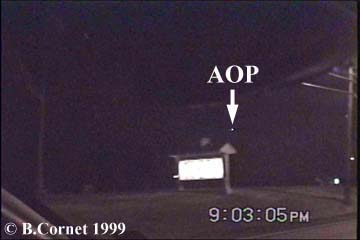
|
Cornet suggested that when the traffic light turned green, he should pull over to the shoulder of the road and stop, which Fischer did. The AOP moved forward with the car, and then stopped again as the car stopped (see second animation below). A street light, which was about a block away, was in the same direction as the AOP, which stopped just to the left of that light. To the left of the car is an industrial park containing various manufacturing plants, buildings, and parking lots with many trees around each building/warehouse complex.
Stars will seem to do the same thing, which is why skeptics will make light of someone saying that a light in the sky was pacing their car. Cornet pointed the light out to Fischer as they stopped on the shoulder of the road. As Cornet began to point to the AOP, it reversed direction and began to head back towards them, ruling out the star or Venus hypothesis. Cornet had been paced before by AOP while driving. To him this was familiar AOP behavior. Back in October 1994 he had been paced 72 miles by a light, which at the end of his trip posed for his camera at a busy intersection by moving to the left of his truck, hovering, and turning on a set of multicolored lights (see The Escort).
After they stopped on the shoulder of the road, Cornet zoomed in on the AOP as it made a rapid approach from the southeast. The AOP descended rapidly as if simulating a conventional aircraft on approach to an airport runway, but there is no airport in the area (see map below). To the north an old WWII landing field has long since been converted to an 18 hole golf course. Large trees grow where the old runways use to be.
To their surprise the AOP descended below roof top level and behind a cluster of buildings across the road.
Think about it: If you saw what might at first look like a conventional aircraft descending, you would probably think that there was an airport near by and it was making a landing approach, right? If the lighting on the object resembled - even remotely - that of airplane navigation lights, you might not think anything was amiss until it dropped down behind and below the tops of buildings in an area you knew did not have a place big enough or long enough to accommodate a conventional fixed-wing aircraft. Fischer's mind was blown away by what he saw, and at first he desperately tried to fit what he saw into a conventional explanation. He was urgently curious and thinking that if he didn't turn around then, he'd subsequently be upset with himself later for not checking that aspect out while it was convenient to do so. He drove back and we checked out the area to make sure there wasn't a landing strip or place there where a plane could land. Only when we could find nothing that matched his expectations did he finally accept the fact that we had been had. The Pine Bush Phenomenon had struck again!!!
Date: 18 December 1999.
Time: 9:00 pm EST.
Location: Bracken Road industrial park, east side of Rte 208; observed from traffic light at Goodwill Road - Rte 208 intersection (red asterisk on map).
Weather: Good visibility with a high ceiling of clouds; air temperature about 30 degrees Fahrenheit. Moon very bright - near full disc.
Witnesses: Bruce Cornet and Herm Fischer.
Sound produced by AOP: None - silent.
Camcorder: Sony Handycam video Hi8, model CCD-TRV81 (3-971-670-0).
Medium: Sony Hi8 MP 8mm videotape, 60 minute.
Duration of video containing AOP: 37 seconds.
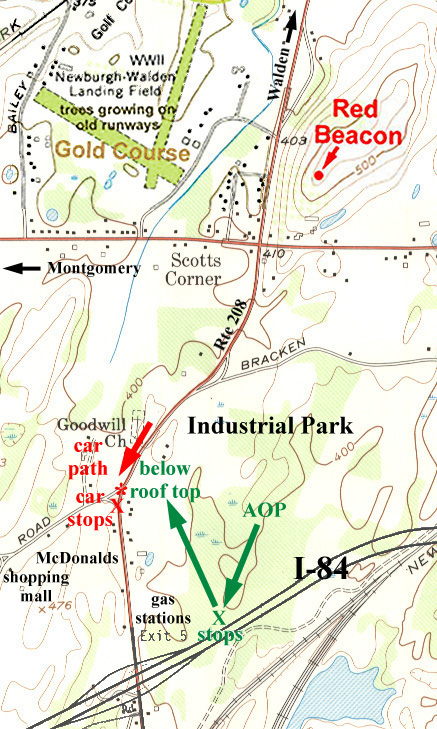
The sighting was recorded on 37 seconds of 8mm videotape, and analyzed frame by frame, with selected frames being transferred to a computer using GrabIT peripheral hardware (Aimes-Lab). Four animated gifs were constructed using those frames: aop18d4a used 58 frames, aop18d4b used 57 frames, aop18d4c used 42 frames, and aop18d2y used 12 frames. Except when editing involved slow motion effects or labels (requiring longer pause times for readability), the timing of frames was adjusted to pseudo-real time or according to the second notation on each frame. If five frames were used for a given second of video time, each frame was given 1/20th of a second on the gif, if ten frames, 1/10th of a second each, etc. Because animated gifs operate (run) differently on different computers and with different web browsers, play time for each animated gif may not be actual time. Observe the seconds time notation on the video time for a sense of real time.
Because each frame was reduced to 25% of its original 720 x 480 pixel size, the compression algorithm averaged brightness for adjacent pixels, thereby reducing the true brightness of the AOP lights. In order to compensate for this reduction in intensity, a single white or lighter-colored pixel was substituted for the brightest central pixel in each light once the frames had been size reduced (to 180 x 120 pixels, 300 x 300 dpi resolution). This was done so that the lights would appear close to their brightness on the original video. Each image was re-centered on the gif frame by moving a large block of pixels. This was done in order to remove the effects of camera movement and to show AOP movement as it was observed. In the third or last animated gif adjustments were made in image position so that the building roofs, which become visible in the last frames, do not jump around due to camera movement.
The video frames had to be reduced from their original large size, which produced a gif in the 5-6 megabyte range. Gifs using frames half that size were in the 2-3 megabyte range. The final gif size for this website is 304K to 421K, which produces a satisfactory download time but limits resolution. Individual frames close to original size and resolution are provided to make up for that loss in quality.
Animated gifs 2, 3, and 4 from video (in sequence from left to right).
|
|
|
The second animated gif on the far left shows the AOP rapidly moving to the south. As the car slowed down for a traffic light in the first animation above, the AOP slowed also, matching the relative (apparent) speed of the car. You can see this by watching the spacing between the car roof support on the left and the AOP. As the car pulled off the road in the second animation, the AOP again slowed down and stopped as the car stopped.
If the AOP had been a very great distance from the car, it would have behaved like a star, creating an illusion of pacing. However, as you watch the animated gifs, it will become apparent that the AOP is much closer to the car than a star. In order to create the illusion of pacing, it had to travel much faster than the car (its relative speed is evident in the gifs). The first gif takes the action up to and just after the AOP rapidly slowed and stopped (behind or "near" a street light in the foreground), where it began to reverse direction and come back towards the camera.
Cornet and Fischer exchange comments as Cornet points to AOP (click on audio control below: 130K).
The third animated gif in the middle shows the AOP rapidly moving to the left as it came closer to the camera. Cornet zooms in on the AOP in order to reveal its pattern of lights. He had to refocus his camera manually when the automatic focus lost resolution. A second is omitted from the animation when the AOP passed behind the car roof support (and is not visible).
The fourth animated gif on the far right shows the AOP at near maximum zoom. The unusual light effects and wobbling of some lights is not due to the camera, because the position of other lights remains unchanged. Care was taken not to change the relationship between any of the lights when the image was re-centered on the gif frame. Any pixel variation close to and around the AOP lights in the size-reduced frames is mostly due to a software compression artifact (see comparison below), although the compression may have enhanced noise or very low intensity lighting or reflections off the surface of the AOP. Note the reduction in light intensity, with the far right light almost disappearing. That is why the lights had to be manually enhanced (method described above).
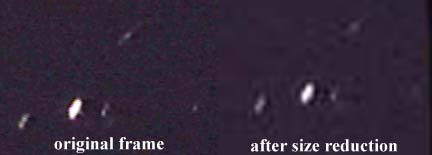
Selected frames from fourth animated gif (top down on left, right), showing AOP descending behind the roofs of two buildings in the foreground.
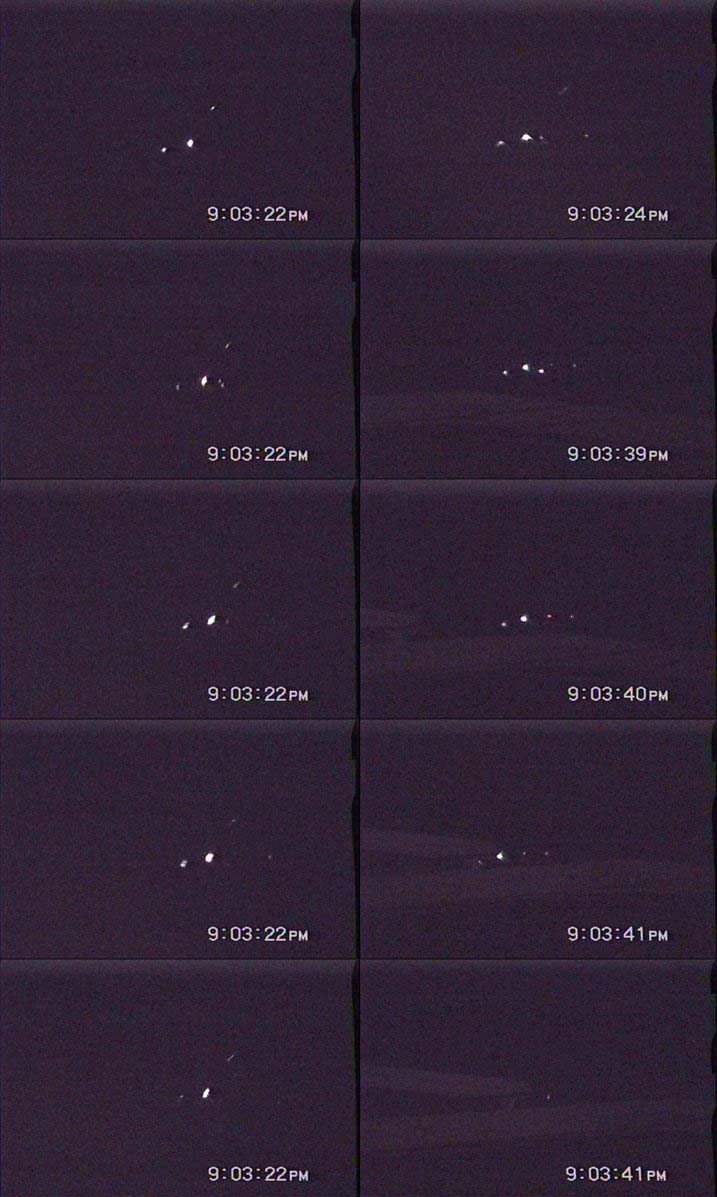
Roofs to two buildings visible above.
The lighting pattern of the AOP is not like that of a helicopter, especially when one considers the light situated well above the other lights in a position where the blades of a helicopter would be. If that light was situated on a pole, it was deliberately put there, but why? The tail fin on an airplane or on some helicopters is not tall enough relative the the spread of the lower lights to provide an explanation for the position of this light. In addition, the top light waves back and forth as the AOP moves through the air, implying that it was located on a flexible pole or shaft and not on a rigid tail structure.
In the fourth animated gif the lights do something unusual. They seem to extend out for a distance and then snap back, producing a shaft of light connecting their original position with their extended position (images below). As the lights changed in intensity (pulsed on and off), so did their shafts, implying that whatever the cause, the effect was comprehensive and not selective. The AOP was not being videotaped through the curvature of the front windshield at the time, but through the flat side window of the car. Therefore the anomaly cannot be explained by distortion through curved glass. Was this special effect part of the performance? I have no mundane explanation for it.
Selected frames from fourth animated gif (top down on left, right).
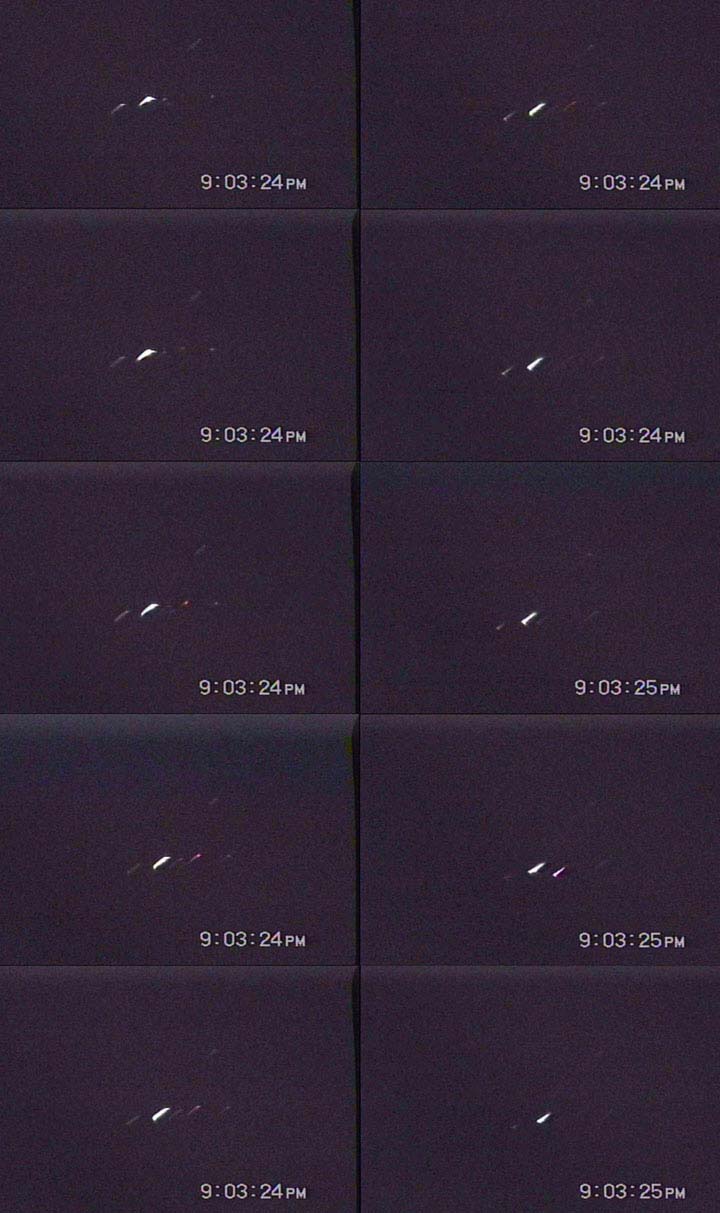
Disappearance Below Roof Tops
On the video the AOP appears to descend slowly behind a set of buildings. Fischer made the comment that there had to be an airport there for a plane that large to land. But the satellite image below (taken in 1992) shows no landing strip or airfield. A very large industrial building is present in the upper left part of the image, along with several open farm fields. The orange line represents the estimated path of the AOP before it stopped by the street light. The red line represents the path of the AOP as it descended behind the buildings just north of the red X. Because a parking lot exists behind the buildings, and a long farm field behind the parking lot, it is more than likely the AOP descended into one of them. At that time of night few if any cars would have been parked in the parking lot.
Analysis of Stop and Reversal
The manner in which the AOP stopped is not like that of a conventional aircraft with wings, nor like that of a helicopter or jump jet. The second animated gif above gives a realistic impression (in pseudo-real time) of just how fast the AOP slowed down and stopped in midair. The fact that it did stop rules out a conventional aircraft dependent on wings for lift and flight. The fact that it stopped so fast restricts its identification to a helicopter if it was a machine designed by humans.
The set of 21 images assembled below represents successive individual frames (at maximum resolution without enhancement) showing the AOP slowing down, stopping, and then reversing direction. It did not turn around. You can see a smaller blurred light to the left of the central light in all or most of the images, and no comparable (symmetrical) light on the right side. The left light would have switched sides had the AOP turned around (180 degrees). The fact that this light does not change position indicates that the AOP stopped and then reversed direction. If it had initially been traveling backwards, it stopped and then traveled forwards. If it had initially been traveling forwards, it stopped and then traveled backwards. Even a helicopter pilot would have had difficulty performing such a stunt.
Images from video of stop and reverse.

If it had been a helicopter, why such a stunt with performance precision? Why create the illusion of pacing our car? How did the pilot target us or recognize us from that distance? Seeing us at night from that distance might not be that difficult using the latest night vision equipment, but recognizing us would be a problem for human surveillance if our car had not been under constant observation (or identified in some other way beforehand).
When examining the time exposures taken that night, during a busy interval of airtraffic (six planes or objects in the sky overhead at the same time) one set of lights in the sky turned out to be something else. It gave a "sign" like that of the AOP in The Transformation performance, lighting up the sky with flaring plasma lights and producing a different-colored aura that extended hundreds of feet beyond the lights (a typical AOP characteristic: See The Illusion and Cemetery Sighting). Note the similarity of the two AOP below, especially the green hue cast around both orange-white lights. Each light then transformed from a glowing ball of plasma into a recognizable pattern of aircraft navigation lights and strobes. Conventinal aircraft cannot do this, period!
In order for the AOP to create the image captured by the camera, which shows the transformation taking place, the pilot or intelligence operating the AOP had to be aware of our presence and had to know when Cornet was taking a photograph. Otherwise it was incredible luck. Do you think any human technology exists which would allow someone to perform such a feat? If so, what would it cost and who has the time and interest to do it? Be realistic. If you think it was coincidence, calculate the astronomical probabilities.
As I was making the animated gifs and reviewing the 18 December videotape I noticed something unusual just after I began videotaping the AOP. As the car moved towards a street light, its light momentarily illuminated something just outside the front windshield and just below the roof. It can be seen in the first animation at 9:03:07 seconds. When that type of car was examined to determine if anything in or on it could have produced the reflection, nothing matched the anomaly that was found. If it is not a reflection off the windshield, it may be a robotic probe sent by the AOP. See Robotic Probe?
It is difficult to imagine the 18 December event as random or coincidence. Fitting a square peg into a round hole in order to explain away what the video captured is not logical, not science, and not honest. Don't forget that the AOP did all of this without creating any sound.
What was the meaning of this performance? Based on the behavior of the AOP, it was stalking our car. As soon as I recognized it and pointed to it (clearly indicated on the video), it began coming towards us. It then descended into an area of warehouses, office buildings, and equipment yards. It is highly unlikely that it landed. It may have ducked out of sight, stopping and hovering over an open space large enough for it to fit into. I will have to go back there during the daytime in order to identify what is beyond the building behind which it disappeared (see fourth animated gif).
Almost all the performances of AOP which Cornet has recorded (many of which are published on his web pages) possess a kind of showmanship. In other words, the pilot or intelligence directing the flight of the AOP was trying to show the observers something. In most cases there was a degree of mimicry, where the AOP employed a lighting pattern and sometimes sounds to give the illusion of a conventional aircraft. Yet there was always something wrong with the picture (or sound) when studied carefully (if recorded, that is). Consistent with this pattern of behavior, the 18 December performance contained information which mimicked the pattern of lights of a conventional aircraft (but with obvious errors) and mimicked the flight pattern of a jetliner on approach to an airport runway. The only problem with that explanation is, had this been a conventional jetliner, it would have landed on something other than a runway, and would have crashed.
One possibility for the performance was an initiation for Herm, who had traveled from California to the East Coast on business, and wanted to use the opportunity to see my study area. The fact that the intelligence behind the performance waited until we were about to get onto the highway (and leave the area) may contain a message: "We know you are here; we know you came looking for us; we want to let you know that we are still here and willing to show up on special occasions. But we are not prepared to give you additional performances as in the past until you are ready to study us more scientifically, using your latest technology and instruments. You need to move beyond the SETI mentality." In other words, the hundreds of performances given to Cornet over a five year period cannot be improved upon until the observers are prepared to improve their observation techniques and methods. "If you want us to get closer to you, you have to get closer to us (by improving your ability to see us with instrument eyes)."
Another possible explanation for the performance is a big tease or gaming ploy. "Oh, those silly humans are back looking for us. Let's give them something at the very end of their visit when they are tired and their ability to respond quickly and intelligently is more diminished. Let's give them a show that will test their ability to observe and analyze what happened."
Could either of these explanations be correct (or a combination of the two)? I don't know. Do you?
Fischer gave the following comments or analysis after reviewing the animated gifs on this page: "Boy do those lights wobble. Perhaps if they are some sort of steered orbs, pods or small separately steered emitters, then they are subject to the drafts of warehouse building heat pump fans, small near-ground winds, etc. Doesn't seem like they are all attached with struts to some ID4-like vehicle. Maybe like the "UFO" of the Olympics 84 opening ceremony (below the piloted vehicle on several 1000 feet of cable, wormhole-wire, or negative energy pod)." (Fischer has a degree in physics from UCLA).
My reply: I think that everything we saw and recorded on video is exactly what the pilot wanted us to see and record. There is evidence for steered orbs and pods, however (see the 2 June 1993 performance at ETI Communication). I also suspect that some of the "wobble" to the lights may have been due to light distortion through an energy field around a central structure, complicated by the pilot turning on and off different closely-spaced lights. To see other animated gifs showing similar examples of light manipulation, go to the Light Show and Another Performance).
Skeptic's Corner |
Review of Evidence |
| The light was a star low on the horizon and created an illusion that it was pacing your car. | No bright stars (magnitude 1.0 or less) were visible in that area of the sky (or on star charts) and high clouds obscured most stars. |
| It was a plane that turned towards the camera, and therefore seemed to stop in midair. | If that is true, it had to turn twice, coincident with each time the car stopped, and the pilot had to dim its lights so that they would not brighten when turned towards the camera. |
| It was a helicopter, which can stop and hover. | Helicopters cannot stop that fast after traveling at a high rate of speed. When it reversed direction, it did not turn around. Helicopters have difficulty traveling backwards, especially at a high rate of speed and with poor rear visibility for the pilot. |
| It was a conventional jetliner on approach to a local airport. | There are no functional airports in the vicinity or anywhere near where the object disappeared below roof top level. In addition, it made no sound as would a commercial or private jet or helicopter. |
| The jiggling of the lights was due to a hand held camcorder. | Yes, the camcorder was hand held, but the anti-jiggle function was engaged and all the lights do not jiggle in unison, which would have to happen if camera movement were responsible. |
| It was an aircraft landing at a distance, and you only thought that it disappeared behind the building across the street. | The Sony camcorder used to record the event has a 30x zoom capability, not enough to enlarge with resolution an aircraft from a distance of more than a quarter mile to the size of the image in the video. There were trees behind the AOP where it went down, ruling out the possibility that it could have been imaged from a distance of more than a quarter mile. |
| There was a landing strip behind the building where it disappeared and you failed to see it. | Do you see any airstrip indicated on the map provided in the area where the AOP disappeared? There is no place long enough or wide enough without obstructions for a conventional fixed-wing aircraft to land where the AOP disappeared. |
| You must be mistaken. Anecdotes are not evidence. | Videos are evidence, however, and everything that was described can be seen happening in the video. |
| I don't believe it. It must be a hoax. | Beliefs are irrelevant. Only facts count. Denial and excuses will not change the facts. |
The Pine Bush Phenomenon is not dead, just mostly dormant. It may be waiting for humans to get smart and stop all the denial and skeptical explanations. It may be waiting for us to develop a strategy, a plan, and a method for analyzing the information they are willing to give us. That will require the use of the latest instruments and technology available, which means that it will cost a lot. It will also require more mainstream scientists and engineers to become challenged by the phenomenon and want to investigate it. It will require government and/or private funding to pay for the salaries of those who are hired to work on the project. It will require the very same type of effort NASA employs to send probes to Mars, as well as a more open attitude on the part of scientists to take risk in exploring a subject which has been ridiculed and dismissed much too often. It will require humanity to grow up and realize that extraordinary phenomena require extraordinary efforts to investigate them, and not some retarded response that makes the respondent look unintelligent, incompetent, dishonest, and/or in denial (the default condition which disqualifies the skeptic).
It is time for a change. Anomalistic Observational Phenomena will not go quietly into the night and disappear. The methods and tactics of ridicule, disinformation, and unavailability of funding used to date have not worked in silencing the phenomenon. They have instead made humans look stupid. Are you one of them? Let's prove that humans can investigate a phenomenon which appears to challenge conventional science, and do it correctly and with conviction and funding. In the past humans studied life on this planet which is less intelligent than us. The tables may have been turned or reversed (was that part of the AOP message?). For the first time modern scientists are studying an intelligence equal to or greater than our own (certainly one that possesses technology that surpasses unclassified human technology). Are we up to the challenge? I think so. What do you think?
Copyright B. Cornet 1999
Date this web page was last modified: 09/17/06